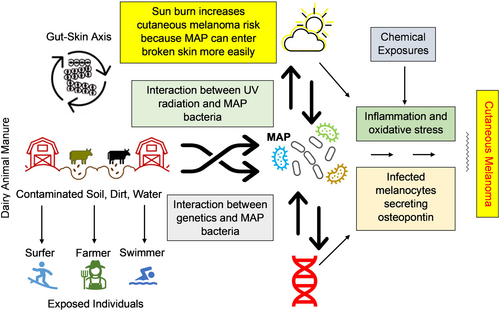MedComm-Oncology | Pathogenic mechanisms and etiologic aspects of Mycobacterium avium subspecies paratuberculosis as an infectious cause of cutaneous melanoma

Open the phone and scan

Mycobacterium avium subspecies paratuberculosis (MAP) exposure and related risk factors for cutaneous melanoma. Cutaneous melanoma is hypothesized to result from the interplay of MAP exposure, genetics, chemical exposures, and ultraviolet (UV) radiation. This combination leads to inflammation, oxidative stress, and infected melanocytes, setting the stage for cutaneous melanoma to develop.
Infectious etiologies have previously been proposed as causes of both melanoma and non-melanoma skin cancer. This exploratory overview explains and presents the evidence for the hypothesis that a microorganism excreted in infected ruminant animal feces, Mycobacterium avium subspecies paratuberculosis (MAP), is the cause of some cases of cutaneous melanoma (CM). Occupational, residential, and recreational contact with MAP-contaminated feces, soil, sand, and natural bodies of water may confer a higher rate of CM. Included in our hypothesis are possible reasons for the differing rates and locations of CM in persons with white versus nonwhite skin, why CM develops underneath nails and in vulvar skin, why canine melanoma is an excellent model for human melanoma, and why the Bacille Calmette-Guérin (BCG) vaccine has demonstrated efficacy in the prevention and treatment of CM. The pathogenic mechanisms and etiologic aspects of MAP, as a transmittable agent underlying CM risk, are carefully deliberated in this paper. Imbalances in gut and skin bacteria, genetic risk factors, and vaccine prevention/therapy are also discussed, while acknowledging that the evidence for a causal association between MAP exposure and CM remains circumstantial.
Article Access: https://doi.org/10.1002/mog2.72
More about MedComm-Oncology: https://onlinelibrary.wiley.com/journal/27696448
Looking forward to your contributions.


